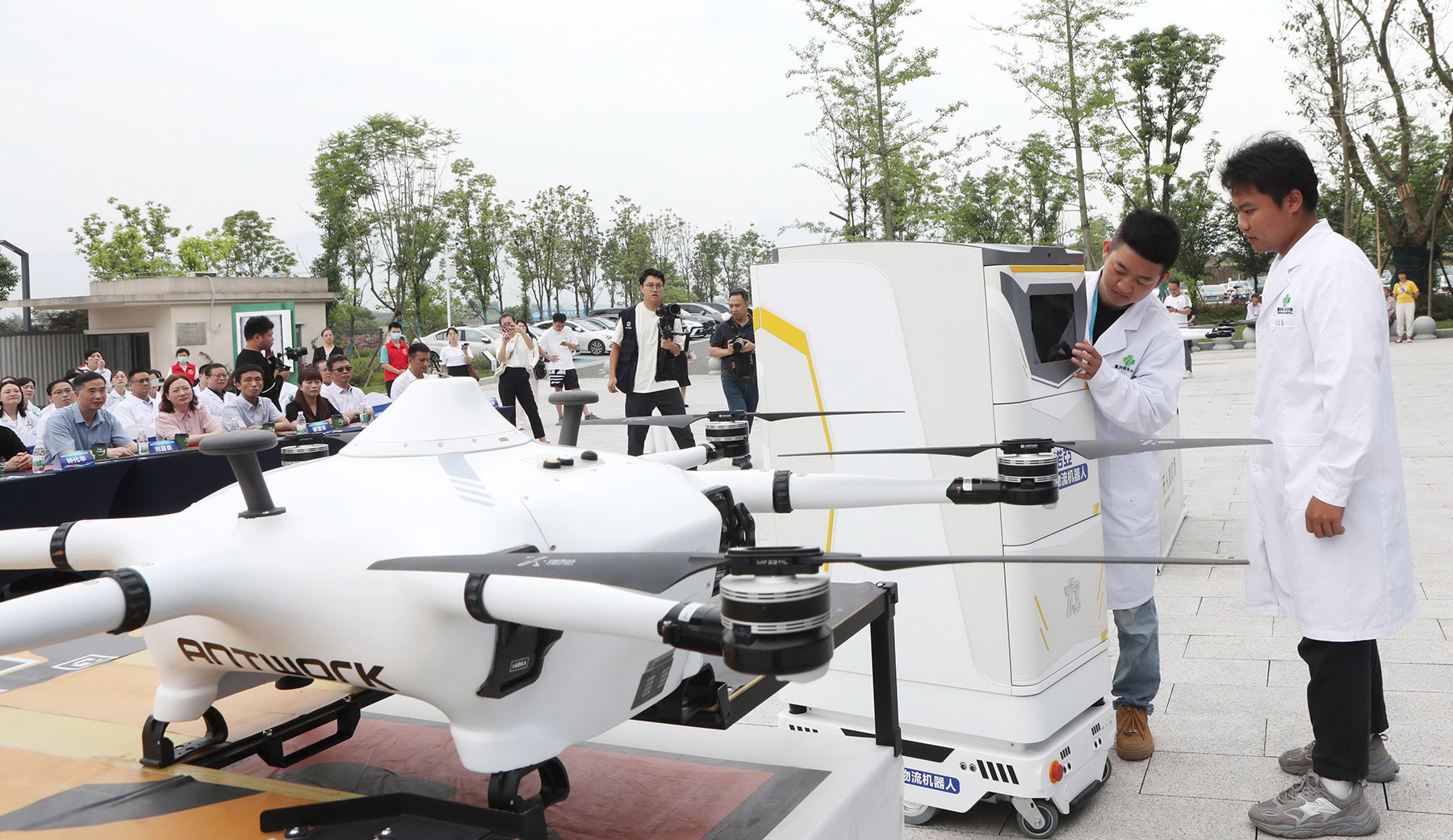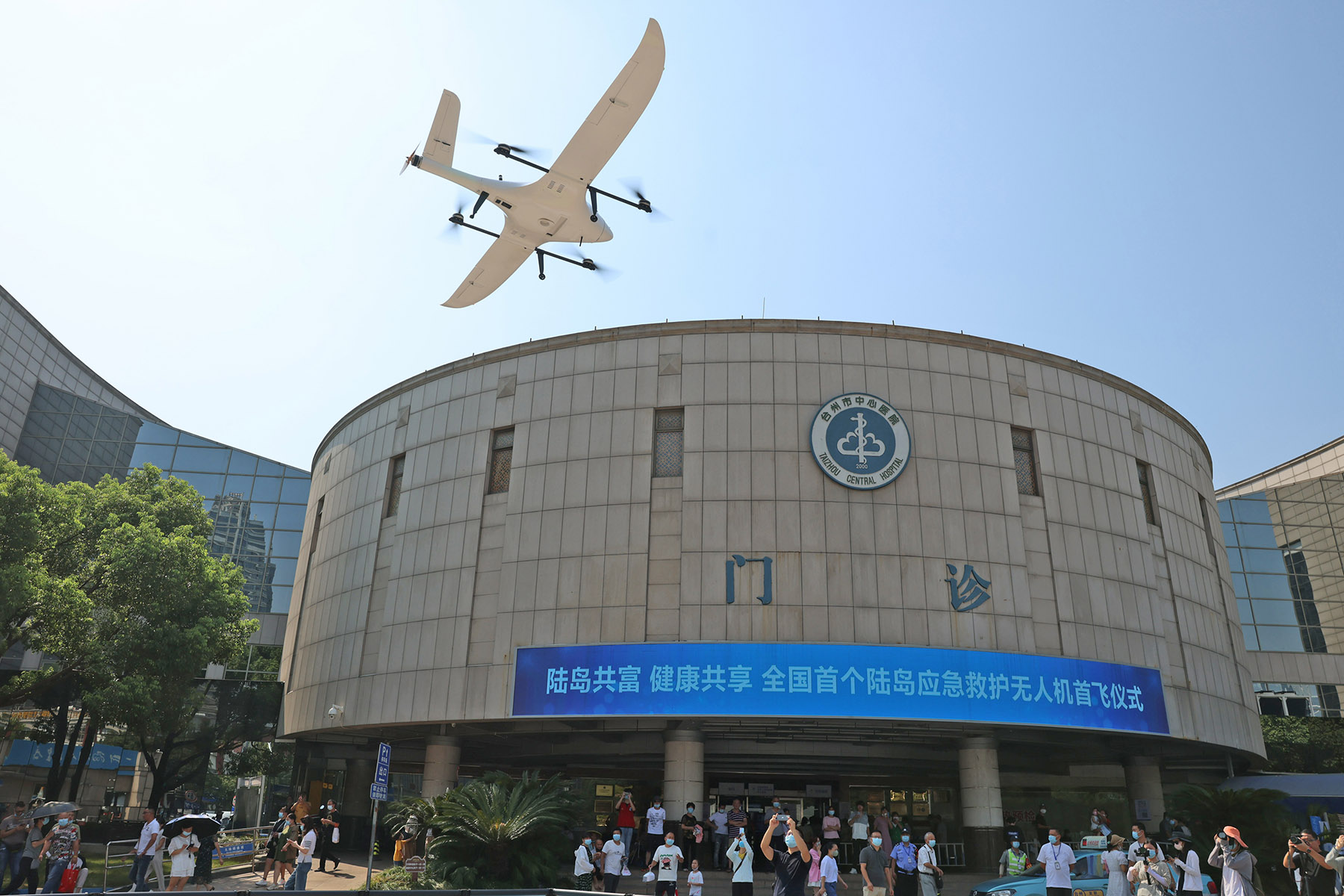Leveraging drones to transport critical medical supplies gains ground in nation

The low-altitude economy, highlighted for the first time in the country's Government Work Report for 2024, is gradually gaining momentum in the medical rescue field in China.
With strategic policies and targeted development plans, provinces and cities are applying drones to transport critical medical supplies like first-aid kits, transfusions and biological samples.
On June 13, a low-altitude logistics drone carrying test specimens took off from the Da'an campus of the Affiliated Yongchuan Hospital of Chongqing Medical University. Following a set route, it flew for 13 minutes and landed smoothly on the Xuanhua campus of the hospital, successfully completing the air transport mission.
The successful maiden flight marks the application of low-altitude drones in medical scenarios in Chongqing. Technicians said that low-altitude logistics drones are like flying 'couriers', with fully autonomous L4-level aerial driving capability and a maximum load capacity of 9 kilograms.
"They have significant advantages in dispatching biological samples including emergency blood and testing apparatus across regions. Reports show that drones have realtime monitoring and temperature control functions, which can take care of blood materials such as red blood cells and platelets that require specific temperature ranges, ensuring specimen safety," said technicians from Yongchuan Hospital.
Some 1,468 kilometers away at the Nanjing Red Cross Blood Center (NRCBC), healthcare practitioners receive requests for emergency blood supplies from Nanjing Pukou People's Hospital. Soon after, a drone carrying some 9 kg of blood products takes off from Gulou district, soaring through a 14.625-km flight route, and arrives at its destination in just 16 minutes.
This is a typical scenario for certain hospitals in Pukou district, Nanjing. Currently, the district has developed two normalized drone routines for critical medical supply transport.
According to the NRCBC, for normal operations, the two routines have four flights per day on average, cutting delivery times by half and greatly improving treatment efficiency.
The drones are capable of carrying medical supplies weighing 10 kg, with a wind resistance level of seven and a flying range of 20 km. They can fly in rainy weather and at night, and come with a parachute for emergency backup. At the same time, they rely on 5G networks for precise navigation and can fly autonomously according to established routes with strong anti-interference ability, thus achieving stable and safe execution of blood transport missions under changing and complex meteorological conditions, said experts from the NRCBC.
According to International SOS, a world-leading health and security services company, a key component of prevention and duty of care is preparing for rare instances when prevention is not possible. Having a safe and executable evacuation plan can make a difference in saving lives. Standards and quality of aviation and aeromedical operations vary significantly across the globe.
"Evacuations often entail accessing both poorly regulated and resourced aviation environments, introducing potential risks. The right provider will have a comprehensive credentialing and accreditation program that is essential to mitigating risks," said the International SOS's spokesperson.

Lin Xianping, secretary-general of the institute of culture and creation at Hangzhou City University, said, "China's low-altitude economy has a wide application and practical value in emergency rescue, as the use of drones provides a safe, flexible and efficient means to save lives."
In terms of blood and test samples, drone deliveries greatly reduce delays and improve treatment efficiency. In addition, drones can serve as mobile communication relay platforms, providing temporary air communication capabilities. Especially during circumstances of ground communication facility damages, they can provide critical communication links, Lin said.
READ MORE: Low-altitude economy poised for takeoff
"Unmanned aerial vehicles equipped with lighting equipment can provide lighting support for night rescues, help locate trapped individuals and guide rescue teams. Meanwhile, UAVs equipped with a delivery system can accurately deliver rescue supplies — such as water, food and medicine — to designated locations, providing necessary survival support for disaster victims.
"Firefighting drones can carry high-definition cameras and thermal imaging devices to monitor the situation of the fire in real-time, quickly transmit fire data, and improve the response speed and firefighting efficiency of firefighters," he added.
The development of China's low-altitude sector is gathering steam. The low-altitude economy is now viewed as a strategic emerging industry and a new growth engine for the country.
A report by market research firm CCID Consulting, a think tank affiliated with the Ministry of Industry and Information Technology, said China's low-altitude economy was worth nearly 506 billion yuan ($69.8 billion) last year, up 33.8 percent year-on-year, and its value is expected to surpass 1 trillion yuan by 2026.
Speaking of future development trends, Yuan Shuai, executive vice-president of the Rural Revitalization Committee, said that with the continuous maturity and popularization of technology, drones can be applied in more and more emergency rescue scenarios, such as fire rescue, earthquake rescue and other calamities rescue.
"By carrying different equipment and sensors, they can achieve various functions such as aerial reconnaissance, material delivery, and personnel search and rescue. In addition, with the integration of new-generation information technologies such as 5G, the internet of things and big data, a new intelligent rescue system is expected to emerge in the low-altitude economy, further improving the response speed and efficiency of emergency rescue," Yuan said.
Hong Yong, an associate research fellow at the Chinese Academy of International Trade and Economic Cooperation's e-commerce research institute, said that as promising as the future may look, challenges in technology, safety, regulations and other areas cannot be underestimated.
"Drone technology requires continuous innovation and progress to meet complex and ever-changing mission requirements. Specifically, in the field of emergency rescue, efforts are needed to ensure flight safety and prevent accidents. The formulation and improvement of relevant regulations are also essential, so as to ensure the legitimacy and standardization of the application of drones in the field of emergency rescues.
"These challenges require the joint efforts of the government, enterprises and research institutions," he said.
ALSO READ: Sky's the limit in UAV autonomous push
On Jan 4, the Ministry of Emergency Management and the Ministry of Industry and Information Technology jointly issued guidance on the development of emergency-use robots. According to the guidance, efforts are needed to break through key technological barriers of collaborative operation in equipment clusters such as drones and robots, as well as human-machine collaborative operation technology.
Meanwhile, it emphasized the importance of strengthening the innovative application of cloud computing, artificial intelligence, big data, and other technologies in emergency robots to enhance their intelligence level.
Key research areas — including UAV group flight technology, cluster control technology, disaster rapid assessment technology, disaster perception ability rapid deployment technology, pre and post-disaster accurate comparison scanning technology — are highlighted, according to the guidance.
Apart from Chongqing and Pukou district in Nanjing, Zhanjiang in Guangdong province, Shijiazhuang in Hebei province, Hefei in Anhui province and others are also taking related actions one after another.


